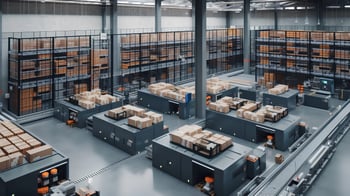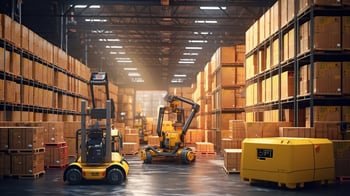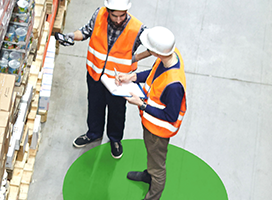
New technologies like artificial intelligence (AI) have impacted most industries. Warehousing and distribution are no exception. AI’s development has revolutionized the logistics field in many ways, empowering businesses to optimize operations, enhance decision-making, and streamline processes. Here’s what you need to know about AI and its role in warehousing and distribution.
What is Artificial intelligence?
Artificial intelligence (AI) is a machine’s ability to simulate human intelligence, especially computer processes. Specific applications of AI include natural language processing, expert systems, machine vision, and speech recognition.
In general, AI systems work by consuming large amounts of data, analyzing that information for patterns and correlations, and using those patterns to predict future events. Depending on the type of program, AI can be learning (machine learning), reasoning, self-correcting, and creative.
Biggest Benefits of Leveraging Industrial AI
Artificial intelligence is an investment, but there are certainly returns that make it worthwhile. Here are some of the main advantages of AI:

- Great at detail-oriented tasks. AI excels at precision tasks, with the ability to get things done with little to no errors.
- Saves labor and boosts productivity. In a tight labor environment, AI can supplement or replace human workers by taking on labor-intensive tasks and increasing productivity.
- Reduces time for data-intensive tasks. AI is able to analyze large amounts of data quickly without errors to deliver helpful insights and optimization suggestions.
- Offers 24/7 availability. AI-powered systems don’t need to take breaks or sleep, so they can provide around-the-clock service.
- Delivers consistent results. The best AI solutions will provide consistent results to businesses.
- Increases employee safety. When taking over labor-intensive or dangerous tasks, AI solutions can increase employee safety.
- Improves customer satisfaction. AI can personalize messaging, recommendations, and fulfillment, so it enhances the customer experience.
The Role of AI in Warehousing and Distribution
AI is a powerful technology that allows warehouses and distribution centers to simplify and automate various processes. Not sure how AI can apply to your business? Here is a breakdown of the current role of AI in the logistics industry.
Logistics Planning
Logistics requires significant that involves coordination of suppliers, workers, and customers. AI can facilitate these planning activities using numerical analytics and scenario analysis. This help with:
- Demand forecasting — Using AI to better forecast consumer demand allows warehouses to order and store only what they need, reducing holding costs and lowering the chances of stockouts.
- Supply planning — AI can analyze a business’ supply needs in real-time to ensure the warehouse doesn’t run out of critical supplies (packaging materials, etc.), while minimizing storage costs and reducing waste.
Autonomous Vehicles
 Autonomous vehicles are devices that operate without human intervention using the assistance of AI. These include devices like self-driving vehicles and drones. In a warehouse or distribution center, self-driving forklifts can move items from one part of the warehouse to another, saving time and money.
Autonomous vehicles are devices that operate without human intervention using the assistance of AI. These include devices like self-driving vehicles and drones. In a warehouse or distribution center, self-driving forklifts can move items from one part of the warehouse to another, saving time and money.
Drones powered by AI are becoming widely used in warehouses for a variety of purposes. Combined with RFID tags, drones can count inventory in real-time. They can also locate lost items, perform surveillance and security functions, and deliver small items within the warehouse.
Warehouse Automation
According to the 2023 MHI Annual Industry Report, 74% of supply chain leaders are increasing their investments in technology, with 90% saying they will invest over $1 million. Many of those investments will go toward AI-powered automation solutions, such as warehouse robotics.
The warehouse robotics market is booming, with companies investing in solutions that help humans in sorting, picking, transporting, and storing packages. These robots can replace human workers. But, in most cases, they take over repetitive tasks to free up employees for other meaningful work.
Data-Driven Analytics
Warehousing and logistics always involve some inherent uncertainty and risk. To ensure resiliency in the face of these potential risks, organizations must plan for any possible scenario.
Between economic downturns, pandemics, global canal blockages, and major supply chain disruptions, managing risk has become critical.
AI-risk management tools can help businesses plan better by modeling different scenarios. For example, predictive analytics tools can review historical data and apply statistical models to forecast factors, such as inventory, supply and demand, warehouse space, truck driver capacity, and supply and demand.
AI can also be used for dynamic pricing, where the prices of products can change in response to supply and demand. This allows businesses to be more competitive by adjusting faster to real-time market conditions.
Transportation Optimization
 One place where AI truly shines in logistics is transportation optimization. For example, AI can be used to find the most optimal shipping routes by analyzing capacity data, weather reports, traffic information, real-time tracking data using RFID, and other details to choose the best possible route each time.
One place where AI truly shines in logistics is transportation optimization. For example, AI can be used to find the most optimal shipping routes by analyzing capacity data, weather reports, traffic information, real-time tracking data using RFID, and other details to choose the best possible route each time.
Using route optimization powered by AI allows logistics companies to secure faster delivery, which lowers costs and keeps customers happy. It also reduces fuel expenses and driver hours necessary to move the same products.
Back Office Operations
Back office operations are essential for any business, including those in the logistics industry. AI plays a critical role in improving the accuracy and speed of many back-office operations.
Combining Robotic Process Automation (RPA) with AI, businesses are now using something called cognitive automation. This enables employees to boost accuracy and productivity in a variety of repetitive processes, like billing and procurement.
As the world becomes more and more digital, the role of AI in warehousing and distribution has become more critical than ever. These innovative technologies are revolutionizing the way warehouses are managed and run, reducing costs, improving efficiency, and increasing accuracy in a variety of tasks.












